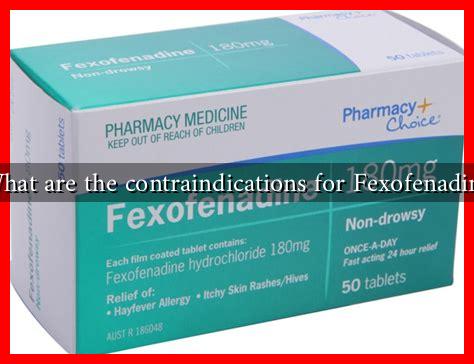-
Table of Contents
What are the Contraindications for Fexofenadine?
Fexofenadine is a widely used antihistamine primarily prescribed for the relief of allergy symptoms such as hay fever and hives. As with any medication, it is crucial to understand its contraindications to ensure safe and effective use. This article delves into the contraindications of fexofenadine, providing insights into who should avoid this medication and why.
Understanding Fexofenadine
Fexofenadine is a second-generation antihistamine that works by blocking the action of histamine, a substance in the body that causes allergic symptoms. Unlike first-generation antihistamines, fexofenadine is less likely to cause drowsiness, making it a popular choice for individuals who need to maintain alertness while managing their allergy symptoms.
Key Contraindications for Fexofenadine
While fexofenadine is generally considered safe for most individuals, there are specific contraindications that should be taken into account:
- Hypersensitivity: Individuals who have a known allergy to fexofenadine or any of its inactive ingredients should avoid using this medication. Allergic reactions can range from mild skin rashes to severe anaphylactic responses.
- Severe Kidney Impairment: Patients with severe renal impairment should use fexofenadine with caution. The drug is primarily excreted through the kidneys, and impaired kidney function can lead to increased drug levels in the body, heightening the risk of side effects.
- Pregnancy and Breastfeeding: Although fexofenadine is classified as a Category C drug by the FDA, meaning that risk cannot be ruled out, it is generally advised that pregnant or breastfeeding women consult their healthcare provider before using this medication.
- Children Under 6 Years: Fexofenadine is not recommended for children under the age of 6 due to a lack of sufficient safety data in this age group.
Potential Drug Interactions
In addition to the contraindications mentioned above, it is essential to consider potential drug interactions that may affect the safety and efficacy of fexofenadine:
- Antacids: Antacids containing aluminum or magnesium can reduce the absorption of fexofenadine, leading to decreased effectiveness. It is advisable to space the administration of these medications by at least two hours.
- Rifampin: This antibiotic can significantly decrease the plasma concentration of fexofenadine, potentially reducing its effectiveness.
- Other Antihistamines: Combining fexofenadine with other antihistamines can increase the risk of side effects without providing additional benefits.
Case Studies and Statistics
Research has shown that while fexofenadine is effective for many, certain populations may experience adverse effects. A study published in the Journal of Allergy and Clinical Immunology indicated that patients with pre-existing kidney conditions had a higher incidence of side effects when using fexofenadine compared to those with normal kidney function. Furthermore, a survey conducted by the American Academy of Allergy, Asthma & Immunology found that approximately 10% of patients reported allergic reactions to fexofenadine, underscoring the importance of screening for hypersensitivity.
Conclusion
Fexofenadine is a valuable medication for managing allergy symptoms, but it is not suitable for everyone. Understanding its contraindications—such as hypersensitivity, severe kidney impairment, and specific age restrictions—is crucial for safe use. Additionally, being aware of potential drug interactions can help prevent adverse effects and ensure the medication’s effectiveness. Always consult with a healthcare provider before starting any new medication, especially if you have underlying health conditions or are pregnant or breastfeeding. By being informed, patients can make better decisions regarding their allergy management and overall health.

